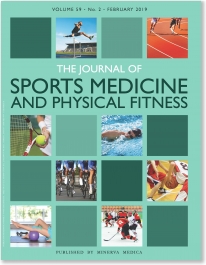Publications

The use of adaptive neuro-stimulation for rebalancing posture and muscular tone in a soccer team
Authors: Giovanni Barassi, Rosa G. Bellomo, Annamaria Porreca, Giuseppe Giannuzzo, Niki Giannandera, Letizia Pezzi Matteo Crudeli, Christianpasquale Visciano, Raoul Saggini
Affiliations: Department of Medical and Oral Science and Biotechnologies, “Gabriele d’Annunzio” University, Chieti-Pescara, Chieti, Italy; Department of Biomolecular Sciences, “Carlo Bo” University, Urbino, Pesaro-Urbino, Italy; Department of Economics, “Gabriele d’Annunzio” University, Chieti-Pescara, Chieti, Italy
Journal: The Journal of Sports Medicine and Physical Fitness (DOI: DOI: 10.23736/S0022-4707.19.09311-3)
-
Field & Applications:
- Clinical trial
- Injury prevention
- Muscle symmetry
- Sport
Background: Posture and somatic structure could positively influence athletic gestures for their biomechanical implications. Working on neuromuscular activity, offers the possibility of intervention on postural control. The aim is demonstrating the possibility of interacting with the human body system through the spinal reflex pathway, starting from the stimulation of cutaneous receptors.
Methods: In this study, developed inside the Chair in Physical and Rehabilitative Medicine, at G. d’Annunzio University, twenty soccer players were recruited. Population: males between 25.5 ± 10.6 years old. Patients were divided using a single-blind criterion into two groups, each containing ten subjects. The experimental group was treated with 2 pre-set programs 4 times a week with an Adaptive Neuro-Stimulation (ANS) able to interact with cutaneous receptors through an ENF Physio® device with a range of electrical frequency of about 15-350 Hz; the placebo-controlled group received the treatment with the device switched off. Patients performed a myometric evaluation with the MyotonPRO® system and a postural one with the Rarog system at T0 before the treatment and at T1 after the four-week treatment.
Results: After our intervention, we identified an improvement in muscular tone, in particular in the hamstring muscles (17.69%, R p<0.01 / L p<0.05 ) and a rebalancing of the principal bone points in the postural system (shoulder 71%, p<0.05, hips 65.6%, p=0.056, sagittal “AP” and frontal “LL” centre of gravity, respectively 40%, p<0.05 and 52.7%, p=0.01 ).
In conclusion, we could hypothesise the usefulness of an Adaptive Neuro-Stimulation to act on these parameters. Clinical rehabilitation impact – Adaptive Neuro-Stimulation could be used not only for treatment of injuries but also in the field of prevention.
Keywords: Sport, Injury prevention, Posture, Soccer
An adequate postural setting and a balanced muscular tone are fundamental in the maintenance of the highest possible state of health in subjects.
The conservation of this balance is also important for athletes, for whom it is necessary to guarantee the highest grade of performance.
The aim of our study was to demonstrate how, through the use of an electro-medical instrument normally used in the rehabilitative field, the Enf Physio®, we could provide support for the athlete, guaranteeing him a preventive treatment with the final goal being the rebalance of muscular tension and postural symmetry.
The results we obtained show an effective improvement of muscular tone, both in the TR and NTR group, but with a major variation in the TR group. Postural variations highlighted a general improvement in the TR group, in particular the SH parameter, which underlined an increased symmetry of the shoulders. We did not see a significant variation of muscular elasticity.
After our study, we can finally affirm the usefulness of Enf Physio® to support athletes, readapting the rehabilitative use for a strictly preventive use in the sports environment.
In the future, it could be interesting to develop a complementary study to this one, guaranteeing an increase of the TR group, whose size was too small to provide more accurate variations. In addition, a complementary study could add specific tests with the aim of improving athletic performance and so evaluating the dynamic posture during the specific sport gesture with a dynamic baropodometry test. Finally, it could be interesting also to insert a follow-up of participants to assess the role of this method in the prevention of injuries.


